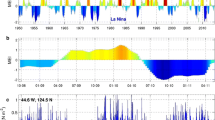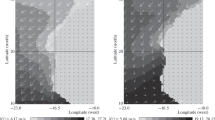Summary
Surface circulation and climate in the sea areas surrounding the American Continents are discussed on the basis of ship observations for the period 1911–1970 compiled with a one degree latitude-longitude square spatial resolution. Charts depict sub-synoptic scale features in considerable detail, such as the wintertime intrusions of cold dry air from the Atlantic to the Pacific side of the Mexican-Central American land bridge at topographically favoured locations, manifesting themselves in plumes of high wind speed, anticyclonic vorticity, and low sea surface temperature far into the open Pacific. Double peaks in the rainy season are indicated for the Western Caribbean and the easternmost Pacific off the Central American coast, with the September/October maximum most dominant. Among the more significant large-scale features are the near-equatorial trough of low pressure, a kinematic axis, and zonally oriented bands of maximal cloudiness and precipitation frequency, with a seasonal migration of this ensemble from a most equatorward position in Northern winter farther northward during summer. The near-equatorial kinematic axis has the characteristics of a confluence zone over the Western Atlantic, whereas over the Eastern Pacific it is a discontinuity between the Southwesterly flow from the Southern hemisphere and the Northeast Trades. Most intense development is reached during Northern summer. The surface flow discontinuity is broadly embedded in the baric trough. The bands of maximal convergence, cloudiness and precipitation frequency stay well equatorward of the surface flow discontinuity in the Eastern Pacific throughout the year, whereas over the Western Atlantic they switch to the North of the kinematic axis during Northern winter.
Zusammenfassung
Klima und Luftzirkulation über den die amerikanischen Kontinente umgebenden Seegebieten werden aufgrund von in Eingradfeldern für den Zeitraum 1911–1970 ausgewerteten Schiffsbeobachtungen besprochen. Großräumige Karten sowie Diagramme und Tabellen des Jahresganges werden für Bodendruck, Wind, Divergenz, relative Wirbelgröße, Wasseroberflächentemperatur (SST), Bewölkung und Niederschlagshäufigkeit dargeboten. Die Karten geben Einzelheiten im subsynoptischen Bereich wieder, wie etwa die winterlichen Kaltlufteinbrüche von der atlantischen zur pazifischen Seite der mexikanischmittelamerikanischen Landbrücke, die sich an orographisch begünstigten Stellen in Zungen von hoher Windgeschwindigkeit, antizyklonaler Wirbelgröße, und niederer SST bis weit in den offenen Pazifik hinein abzeichnen. Eine doppelgipflige Regenzeit ist für das westliche Karibische Meer und den östlichsten Pazifik längs der mittelamerikanischen Küste angezeigt, wobei das Maximum im September/Oktober bei weitem überwiegt.
Zu den bezeichnendsten großräumigen Erscheinungen gehören eine Tiefdruckzone in der Nähe des Äquators, eine kinematische Achse, und zonal angeordnete Bänder von maximaler Bewölkung und Niederschlagshäufigkeit; dieses System ist jahreszeitlichen Verlagerungen von einer äquatornächsten Lage im Nordwinter zu weiter nördlichen Breiten im Nordsommer unterworfen. Die kinematische Achse hat über dem westlichen Atlantik die Eigenheiten einer Konfluenzzone, während sie über dem östlichen Pazifik eine Diskontinuität zwischen der von der Südhemisphäre vordringenden Südwestströmung und dem Nordostpassat darstellt. Eine leichte Doppelwelle im Jahresgang ist nur in der Breitenlage der kinematischen Achse über dem Pazifik zu erkennen. Das System ist im Nordsommer am kräftigsten entwickelt. Die Diskontinuität der Bodenströmung ist in die Tiefdruckzone eingebettet. Die Bänder von maximaler Konvergenz, Bewölkung und Niederschlagshäufigkeit bleiben im östlichen Pazifik ganzjährig erheblich äquatorwärts von der Strömungsdiskontinuität während sie über dem westlichen Atlantik im Nordwinter auf die Nordseite der kinematischen Achse überwechseln. Die für das vorliegende Projekt verfügbare räumliche Auflösung dürfte zum Verständnis der sogenannten „Intertropischen Konvergenzzone” wesentlich sein.
Similar content being viewed by others
References
U. S. Weather Bureau: Atlas of Climatic Charts of the Oceans. Washington, D. C. 1938.
serra, A. B.: The General Circulation over South America. Bull. Amer. Meteor. Soc.,22, 173–179 (1941).
Alpert, L.: The Intertropical Convergence Zone of the Eastern Pacific region, I. Bull. Amer. Meteor. Soc.,26, 426–432 (1945).
Alpert, L.: The Intertropical Convergence Zone of the Eastern Pacific region, II. Bull. Amer. Meteor. Soc.,27, 15–29 (1946).
Alpert, L.: Weather over the Tropical Eastern Pacific Ocean, 7 and 8 March 1943. Bull. Amer. Meteor. Soc.,27, 384–398 (1946).
Simpson, R. H.: Synoptic Aspects of the Intertropical Convergence near Central and South America. Bull. Amer. Meteor. Soc.,28, 335–346 (1947).
U. S. Naval Hydrographic Office: Sailing Directions, West Coast of Central America and Mexico. H. O. Publ. No. 26, Washington, D. C. 1951.
U. S. Naval Hydrographic Office: Sailing Directions, East Coast of Central America and Mexico. H. O. Publ. No. 20, Washington, D. C. 1964.
Lahey, J. F.: On the Origin of the Dry Climate in Northern South America and the Southern Caribbean. Dept. of Meteorology, University of Wisconsin, Scient. Rep. No. 10, 1958.
Hastenrath, S.: On General Circulation and Energy Budget in the Area of the Central America Seas. J. Atm. Sci.,23, 694–712 (1966).
Hastenrath, S.: Rainfall Distribution and Regime in Central America. Arch. Met. Geoph. Biokl., Ser. B.15, 201–241 (1967).
Atkinson, G., and J. C. Sadler: Mean Cloudiness and Gradient-Level Wind Charts over the Tropics. USAF, Air Weather Service Tech. Rep. No. 215, 1970.
National Oceanic and Atmospheric Administration (NOAA): Global Atlas of Relative Cloud Cover 1967–1971. Washington, D. C., 237 pp. 1971.
Bleck, R.: Lineare Approximationsmethoden zur Bestimmung ein-und zweidimensionaler numerischer Filter der dynamischen Meteorologie. Institut Theoret. Meteorol. Freie Universität Berlin, 86 pp., 1965.
Hantel, M.: Wind Stress Curl — the Forcing Function for Oceanic Motions. Studies in Physical Oceanography. p. 121–136, vol. 1. Ed. A. C. Gordon, Gordon and Breach, New York and London. 1972.
Ramage, C. S.: Structure of an Oceanic Near-Equatorial Trough Deduced from Research Aircraft Traverses. Mo. Wea. Rev.,11, 754–759 (1974).
Author information
Authors and Affiliations
Additional information
With 15 Figures
Rights and permissions
About this article
Cite this article
Hastenrath, S. Marine climatology of the tropical Americas. Arch. Met. Geoph. Biokl. B. 24, 1–24 (1976). https://doi.org/10.1007/BF02243381
Received:
Issue Date:
DOI: https://doi.org/10.1007/BF02243381




